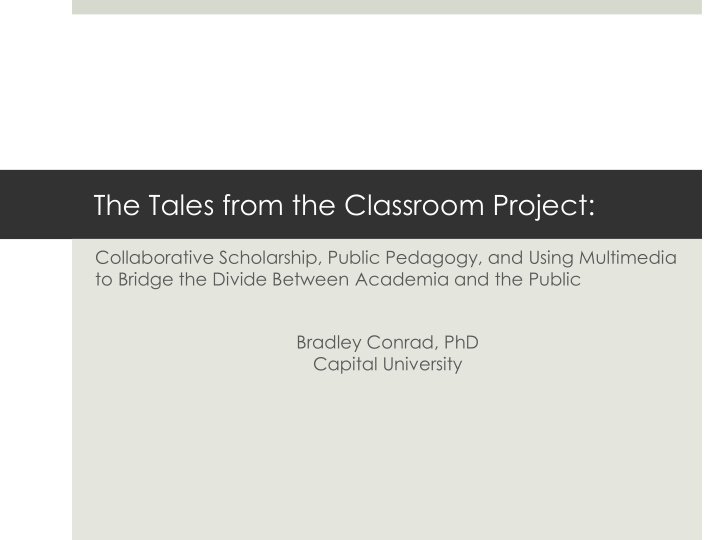



The Tales from the Classroom Project: Collaborative Scholarship, Public Pedagogy, and Using Multimedia to Bridge the Divide Between Academia and the Public Bradley Conrad, PhD Capital University
Academic/Policy Disconnect Academics are of little or no consequence in influencing or shaping educational policy (Swanson and Barladge, 2006)
Academic/Policy Disconnect Of the ten most influential institutions, publications, and people in impacting educational policy: 0 were higher education institutions 0 were scholarly journals 1 was an academic (also a policy person)
The “New Way” to Influence Policy Digital technology has led to the democratization of information with digital technology lowering costs and barriers to the production and consumption of information (Lubienski, Scott, & Debray, 2014)
The “New Way” to Influence Policy Technology and multimedia make it possible to share information with broader audiences, bypassing policymaking gatekeepers (e.g. special interest groups, lobbyists), and can lead to the widespread dissemination of research (Goldhaber and Brewer, 2008).
The “New Way” to Influence Policy To influence policy via media, we must think more broadly and write to policy elites as a target audience, as teachers and education students do not have the policymaking influence they once had (Greene 2011). Reaching broader audiences through multimedia/technology leads to a grassroots-like groundswell of public support for a policy issue and can ultimately lead to social change.
Vision for Tales Four main branches to the project: Book Blog Research Renderings Multimedia
The Book Thirteen Authors Wide Geographic Distribution Across US VA, NM, KY, TX, AK, ID, IL, ME, CO, SD Elementary, Middle, and High Schools Urban, Rural, and Suburban Tell the Story of Students, Teachers, and Administrators Mainstream Audience
The Rest of the Branches Book is an Anchor, but We Have Work to Do: Branding Continue to Develop Website and Social Media Build Multimedia Platform Grow the Blog, Research Renderings, and Other Editorial Content
Tales from the Classroom Website https://www.talesfromtheclassroom.com
Tales from the Classroom Website Contents: Blog Research Renderings Library Info. on the project Info. on the team How to work with us Marketplace (in development) Social Media
The Blog Purpose: Public Pedagogy Tell the Stories of Students, Teachers, and Administrators Open People’s Eyes Encourage Action
The Blog Written in Accessible Language Clarify Jargon Terms Present Problems but Offer Solutions Friendly, Didactic, and at Times, Humorous Tone 1-3 Pages Double-Spaced in Word Catchy Images
Getting Involved with the Blog Tell your story as a student Tell your story as a pre-service or in-service teacher Talk about a triumph that happened in schools Deconstruct an issue affecting schools (with solutions/vision) Highlight something inspiring you would like to see more of
Work with Us: Writing for the Blog Text Blog Writer ’ s Guidelines Length 750-2000 words Longer posts are also accepted (released as a series). Author Information Include your name, email, and institutional affiliation. Include any Instagram, Twitter, or Facebook ID names. You are welcome to include a 50-75 word bio and headshot (optional). Audience Blog posts focusing on current issues/events in K-12 education should be written for a general audience that includes parents, teachers, administrators, support staff, policymakers, and those interested in education. Style The blog seeks to share the voices and stories of those working in or with children/youth in our schools, so write in your authentic voice. Please note: while we welcome deconstructing what is “ wrong ” with education, we ask that you also offer solutions for issues you raise. Tales is about hope and possibility. We invite you to join us in sharing what might be, along with what currently is. Submission Submit your blog posts for review by clicking here. Reviewing Blog posts are peer-reviewed. Rather than rejecting you, we will work with you to ensure a high-quality post. To Learn More We welcome you to read previous blog posts at www.talesfromtheclassroom.com. For additional information, email us at info@talesfromtheclassroom.com.
Work with Us: Blog Features Visions of Good Education Profiles of an Educator Tale Teller’s Spotlight Tales Testimonials Other features
Work with Us: Editorial and Promotional Items Editorial Content Calendar Frequent Blogging Promotion on Social Media Cross-promotion Invited and Guest Bloggers Images (stock photos free and paid) Develop partnerships
Partnerships Teachers College Record Curriculum & Teaching Dialogue InSight Yelp Character Strong Genial.ly Education Elements LivingTree
Research Renderings Getting Research and Theory into the Hands of Educators Render the Essential Elements 250 Words or Less Accessible Language Inform and Pique Interest in the Article Questions to Start a Conversation with a Stakeholder
The Multimedia Platform Adult usage of social media … Twitter, 24% Facebook, 68% LinkedIn, 25% Snapchat, 27% Instagram, 35% Pinterest, 29% * Pew Research Center, 2018
The Multimedia Platform Teen usage of social media … Facebook, 51% Youtube, 85% Instagram, 72% Twitter, 32% Snapchat, 69% * Pew Research Center, 2018
Tales Multimedia Platforms Twitter (@talesfromthecla) Facebook (@talesfromthecla) Instagram (@talesfromthecla) LinkedIn (@talesfromthecla) Pinterest (@talesfromthecla) Medium (@talesfromthecla)
Tales from the Classroom Facebook
Tales from the Classroom Twitter https://twitter.com/talesfromthecla
Tales from the Classroom Instagram
Work with Us: Social Media Help Develop Editorial Calendar Schedule Re-post Blog Stories Help Build a Following on Social Media Develop Relationship with Influencers Identify and Share Articles, Editorials, etc. to Share Follow and Share Trends (Policy or C&I) Meaningful or Informative Quotes
Questions & Answers What Questions do you Have?
Contact Information Bradley Conrad Capital University Email: bconrad2@capital.edu or info@talesfromtheclassroom.com Twitter: @bconradcapital or @talesfromthecla
Recommend
More recommend